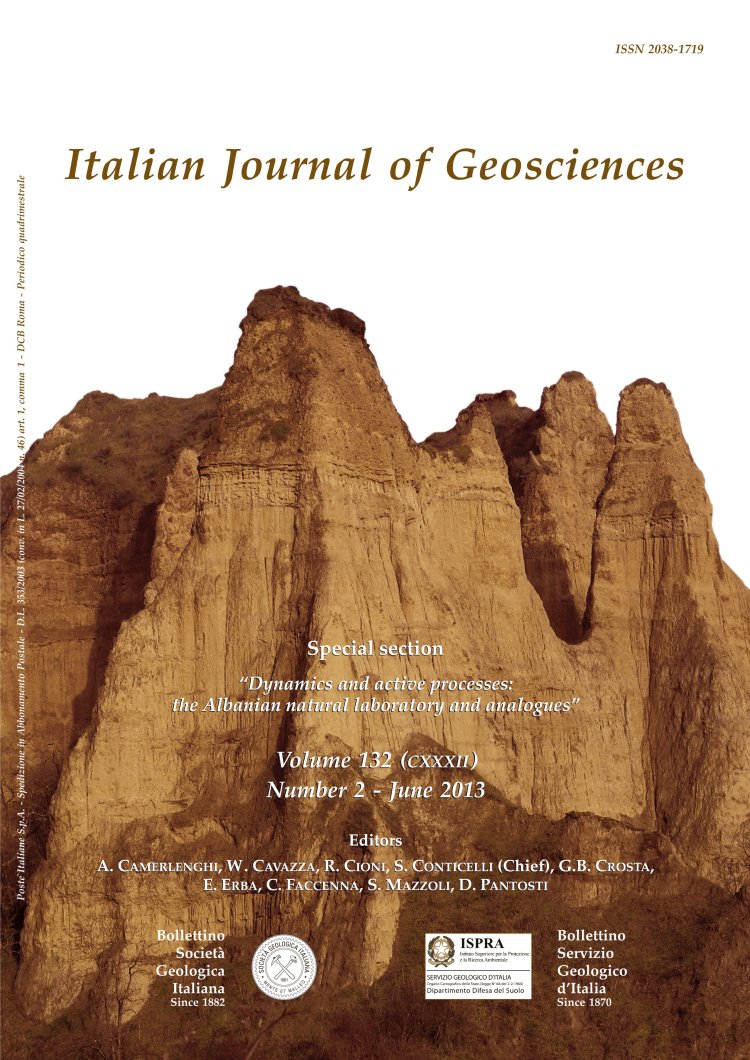
New data on the Pleistocene of Trani (Adriatic Coast, Southern Italy)
Massimo Caldara(1), Antonia Iannone(1), Raffaele Lopez(2), Oronzo Simone(3), Vincenzo De Santis(1), Trinidad Torres(4) & José E. Ortiz(4)
(1) Dipartimento di Scienze della Terra e Geoambientali, Università degli Studi di Bari "Aldo Moro", via Orabona, 4 - 70125 Bari.Tel. 080 5442565, Fax 080 5442625, E-mail: massimoangelo.caldara@uniba.it
(2) Consiglio per la Sperimentazione e la Ricerca in Agricoltura.
U.R. Sistemi colturali caldo-aridi (CRA-SCA), via Celsio Ulpiani, 5 -70125 Bari.
(3) Libero professionista.
(4) Biomolecular Stratigraphy Laboratory, Madrid School of Mines, C/Rios Rosas, 21 - E-28003 Madrid, Spain.
Volume: 132 (2013) f.2
Pages: 239-253
Abstract
Along the Apulian Adriatic coast, in a cliff south of Trani, a succession of three units (superimposed on one another) of marine and/or paralic environments has been recognised.
The lowest unit I is characterised by calcareous/siliciclastic sands (css), micritic limestones (ml), stromatolitic and characean boundstones (scb), characean calcarenites (cc). The sedimentary environment merges from shallow marine, with low energy and temporary episodes of subaerial exposure, to lagoonal with a few exchanges
with the sea. The lagoonal stromatolites (scb subunit) grew during a long period of relative stability of a high sea level in tropical climate.
The unit I is truncated at the top by an erosion surface on which the unit II overlies; this consists of a basal pebble lag (bpl), siliciclastic sands (ss), calcareous sands (cs), characean boundstones (cb), brown paleosol (bp). The sedimentary environment varies from beach to lagoon with salinity variations. Although there are indications
of seismic events within the subunits cs, unit II deposition took place in a context of relative stability. The unit II is referable to a sea level highstand.
Unit III, trangressive on the preceding, consists of white calcareous sands (wcs), calcareous sands and calcarenites (csc), phytoclastic calcirudite and phytohermal travertine (pcpt), mixed deposits (csl, m, k, c), sands (s) and red/brown paleosols (rbp). The sedimentation of this unit was affected by synsedimentary tectonic, attested by seismites found at several heights. Also the unit III is referable to a sea level highstand.
The scientific literature has so far generally attributed to the Tyrrhenian (auct.) the deposits of Trani cliff. As part of this work some datings were performed on 10 samples, using the amino acid racemization method (AAR) applied to ostracod carapaces. Four of these samples have been rejected because they have shown in laboratory recent contamination.
The numerical ages indicate that the deposits of the Trani cliff are older than MIS 5.
The upper part of the unit I has been dated to 355±85 ka BP, thus allowing to assign the lowest stromatolitic subunit (scb) at the MIS 11 peak and the top of the unit I at the MIS 11-MIS 10 interval.
The base of the unit II has been dated to 333±118 ka BP, thus attributing the erosion surface that bounds the units I and II to the MIS 10 lowstand and the lower part of the unit II to MIS 9.3. The upper part of the unit II has been dated to 234±35 ka BP, while three other numerical ages come from unit III: 303±35, 267±51, 247±61 ka BP.
At present, the numerical ages cannot distinguish the sedimentation ages of units II and III, which are both related to the MIS 9.3-MIS 7.1 time range.
However, the position of the units, superimposed one another, and their respective age, allows us to recognise a subsidence phase between MIS 11 and MIS 7, followed by an uplift phase between the MIS 7 and the present day, which led the deposits in their current position. This tectonic pattern is not in full agreement with what is
described in the literature for the Apulian foreland.
Keywords
Get Full Text